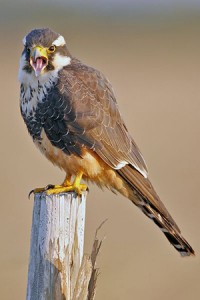Latest update April 4th, 2025 12:14 AM
Aplomado Falcon (Falco femoralis)
Apr 27, 2014 Features / Columnists, Interesting Creatures in Guyana
The Aplomado Falcon (Falco femoralis) is a medium-sized falcon of the Americas. The species’ largest contiguous range is in South America, but not in the deep interior Amazon Basin.
It was long known as Falco fusco-coerulescens or Falco fuscocaerulescens, but these names are now believed to refer to the Bat Falcon (F. rufigularis). Its resemblance in shape to the hobbies accounts for its old name Orange-chested Hobby. Aplomado is an unusual Spanish word for “lead-coloured”, referring to the blue-grey areas of the plumage – an approximate English translation would be “leaden falcon”.
Spanish names for the species include halcón aplomado and halcón fajado (roughly “banded falcon” in reference to the characteristic pattern); in Brazil it is known as falcão-de-coleira.
The Aplomado Falcon is very slender, long-winged, and long-tailed, the size of a small Peregrine Falcon (F. peregrinus), at 12–16 in (30–40 cm) long and with an average wingspan of about 36 in (90 cm), but only half the weight, at about 7.3–10.8 oz (208–305 g) in males and 9.6–16 oz (271–460 g) in females.
In adult birds, the upperparts are dark blue-grey, as is much of the head, with the usual falcon “moustache” contrasting sharply with the white throat and eye stripe. The upper breast continues the white of the throat; there are black patches on each side of the lower breast that meet in the middle; the belly and thighs, below the black patches, are light cinnamon. The tail is black with narrow white or grey bars and a white tip. The cere, eye-ring, and feet are yellow or yellow-orange.
Except that females are bigger than males, the sexes are similar. Juvenile birds are very similar to adults, but their upperparts and belly band are blackish brown, the chest is streaked with black, the white on the head and breast is buffy, and the cinnamon on the under parts is paler, as are the feet.
This species may be confused with the Bat Falcon (F. rufigularis) and the Orange-breasted Falcon (F. deiroleucus), which have similar white-black-rust patterns below, but those species are built more like Peregrine Falcons and have solidly blackish heads and darker rufous bellies. These two species are generally considered to belong to the same lineage as the Aplomado Falcon.
Two other Falco species of the Americas,Merlin (F. columbarius) and American Kestrel (F. sparverius), seem to be closer to the Aplomado group than most other falcons, but the relationships of all these lineages are fairly enigmatic. All that can be said with some certainty is that they diverged as part of an apparently largely western Holarctic radiation in the Late Miocene, probably around eight to five million years ago.
The Aplomado Falcon’s habitat is dry grasslands, savannahs, and marshes. It ranges from northern Mexico and Trinidad to southern South America, but has been extirpated from many places in its range, including all of northern and central Mexico except for a small area of Chihuahua.
Globally, however, it is so widespread that it is assessed as Species of Least Concern by the IUCN.
It feeds on large invertebrates and small vertebrates, with small birds making up the overwhelming bulk of its prey. Mixed-species feeding flocks in open cerrado and grassland will go on frenzied alert upon spotting this species; small birds fear it more than most other predators. It is often seen soaring at twilight hunting insects and eating them on the wing. It also hunts at fields being burned, at which many birds of this species may gather; cooperation between individual Aplomado Falcons – usually members of a pair – has also been recorded. In Brazil, Aplomado Falcons have been observed following Maned Wolves (Chrysocyon brachyurus) and chasing birds that the wolves flush.
Prey items typically weigh one-fifth to one-half of the falcons’ own weight, but females of this species (which due to their size can tackle larger prey) have been recorded eating birds larger than themselves, such as a Cattle Egret (Bulbucus ibis) or a Plain Chachalaca (Ortalis vetula), on rare occasions.
The nest is a platform built of sticks at any height in a bush or tree. Two or three eggs are laid. (Source: Wikipedia – The Free Online Encyclopedia)
Share this:
- Click to print (Opens in new window)
- Click to email a link to a friend (Opens in new window)
- Click to share on Facebook (Opens in new window)
- Click to share on WhatsApp (Opens in new window)
- Click to share on Twitter (Opens in new window)
- Click to share on Pinterest (Opens in new window)
- Click to share on Pocket (Opens in new window)
- Click to share on Tumblr (Opens in new window)
- Click to share on Reddit (Opens in new window)
- Click to share on LinkedIn (Opens in new window)
Related
Similar Articles

The Glenn Lall Show|| March, 31st, 2025
Follow on Tik Tok @Glennlall
THE BLUNT OF THE DAY

Sports
Apr 04, 2025
Kaieteur Sports- The Georgetown Regional Conference continued in thrilling fashion on Wednesday at the National Gymnasium hardcourt, with dominant performances from Saints Stanislaus and Government...Features/Columnists
A coalition of shared disgrace
Peeping Tom… Kaieteur News- The APNU and the AFC deserve each other. They deserve to be shackled together in a coalition... more
Publisher’s Note
Freedom of speech is our core value at Kaieteur News. If the letter/e-mail you sent was not published, and you believe that its contents were not libellous, let us know, please contact us by phone or email.
Feel free to send us your comments and/or criticisms.
Contact: 624-6456; 225-8452; 225-8458; 225-8463; 225-8465; 225-8473 or 225-8491.
Or by Email: glennlall2000@gmail.com / kaieteurnews@yahoo.com
Weekend Cartoon












